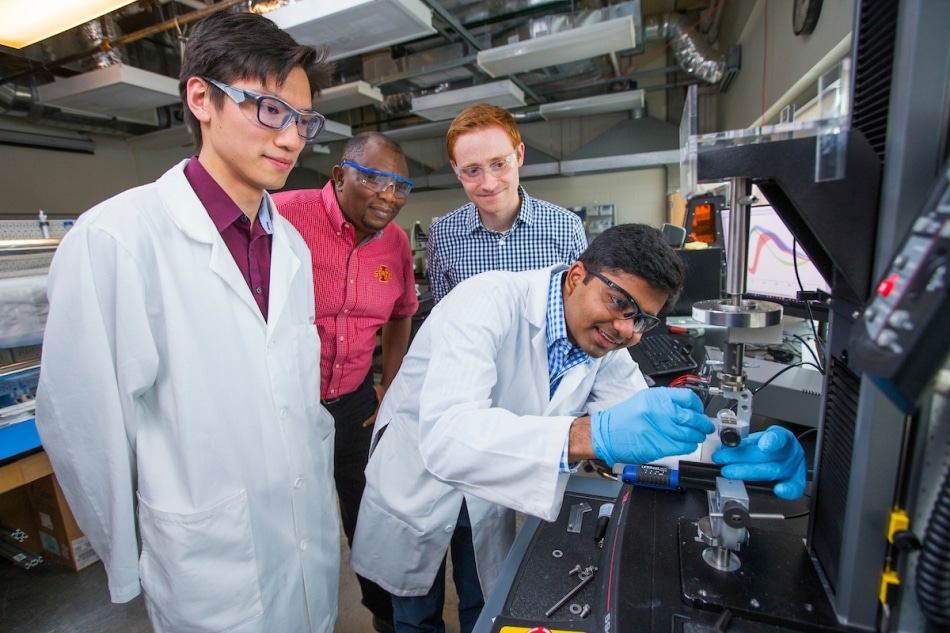Feb 19 2018
Engineers at the Iowa State University have developed a novel smart, responsive material that is capable of stiffening up like a worked-out muscle.
 Iowa State engineers - left to right, Boyce Chang, Martin Thuo, Michael Bartlett and Ravi Tutika - helped develop and describe a new smart material. Here they examine an instrument used for mechanical testing of material properties. (Image credit: Christopher Gannon)
Iowa State engineers - left to right, Boyce Chang, Martin Thuo, Michael Bartlett and Ravi Tutika - helped develop and describe a new smart material. Here they examine an instrument used for mechanical testing of material properties. (Image credit: Christopher Gannon)
According to the engineers, a muscle becomes stronger when it is stressed. When the rubbery material is mechanically stressed, for example, with a bend or a twist, the material automatically stiffens by as much as 300%. In laboratory tests, when a flexible strip of the material was mechanically stressed, it becomes a hard composite material that can support up to 50 times its own weight.
An interesting fact is that this novel composite material does not require external energy sources such as electricity, light, and heat to alter its properties. Also, it can possibly be used in many different ways, including applications in industry and medicine. The material has been illustrated in a paper published online by Materials Horizons – a scientific journal.
The paper’s lead authors are Michael Bartlett and Martin Thuo, Iowa State assistant professors of materials science and engineering. First authors are Ravi Tutika and Boyce Chang, Iowa State doctoral students in materials science and engineering. Boyce Chang is also a student associate of the U.S. Department of Energy’s Ames Laboratory.
The development of the novel material was supported by Iowa State startup funds for Bartlett and Thuo. The project was also supported by Thuo’s Black & Veatch faculty fellowship.
The combination of Thuo’s know-how in micro-sized, liquid-metal particles and Bartlett’s expertise in gels, plastics¸ rubbers, and other soft materials led to the development of the novel material. It is indeed a powerful combination.
The team discovered a simple, low-cost approach to create undercooled metal particles – i.e., a metal that stays liquid even below its melting temperature. To create the extremely small particles (they are just 1 to 20 millionths of a meter across), droplets of melted metal are exposed to oxygen to create an oxidation layer that not only coats the droplets but also prevents the liquid metal from turning solid. The researchers also discovered ways to combine a rubbery elastomer material with the liquid-metal particles, making sure that the particles do not break up.
When this hybrid material is subjected to mechanical stresses such as twisting, pushing, squeezing, and bending, the liquid-metal particles break open. After the liquid metal flows out of the oxide shell, it joins together and solidifies.
“You can squeeze these particles just like a balloon,” Thuo said. “When they pop, that’s what makes the metal flow and solidify.”
The outcome, Bartlett said, is a “metal mesh that forms inside the material.”
Bartlett and Thuo added that the popping point can be adjusted to make the liquid metal flow following different amounts of mechanical stress. Tuning may involve changing the particle sizes, changing the metal used, or changing the soft material.
In this example, Field’s metal, an alloy of tin, bismuth, and indium, is present in the liquid-metal particles, but according to Thuo, other metals will also work equally well.
“The idea is that no matter what metal you can get to undercool, you’ll get the same behavior,” he said.
The novel material could be used in industry to guard valuable sensors or in medicine to support fragile tissues, say the engineers. It could even be used in wearable or reconfigurable electronics or soft and bio-inspired robotics. While the material is available for licensing, the Iowa State University Research Foundation is also working to patent it.
“A device with this material can flex up to a certain amount of load,” Bartlett said. “But if you continue stressing it, the elastomer will stiffen and stop or slow down these forces.”
And that is how they are adding some muscle to their novel smart material, the engineers say.